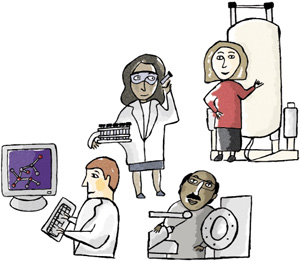Preface: Why Structure?
Like many everyday objects, proteins are shaped to get their job done.
Imagine that you are a scientist probing the secrets of living systems not with a scalpel or microscope, but much deeper—at the level of single molecules, the building blocks of life. You'll focus on the detailed, three-dimensional structure of biological molecules. You'll create intricate models of these molecules using sophisticated computer graphics. You may be the first person to see the shape of a molecule involved in health or disease. You are part of the growing field of structural biology.

Proteins, like many everyday objects, are shaped to get their job done.
The depressions in an egg carton are designed to cradle eggs so they won't break.
The long neck of a screwdriver allows you to tighten screws in holes or pry open lids.
A funnel's wide brim and narrow neck enable the transfer of liquids into a container with a small opening.
The shape of a protein—although much more complicated than the shape of a common object—teaches us about that protein's role in the body.
The molecules whose shapes most tantalize structural biologists are proteins, because these molecules do much of the work in the body.
Like many everyday objects, proteins are shaped to get their job done. The shape or structure of a protein offers clues about the role it plays in the body. It may also hold the key to developing new medicines, materials, or diagnostic procedures.
In addition to teaching about our bodies, these "structures of life" may hold the key to developing new medicines, materials, and diagnostic procedures.
In Chapter 1, you'll learn more about these "structures of life" and their role in the structure and function of all living things. In Chapters 2 and 3, you'll learn about the tools—X-ray crystallography and nuclear magnetic resonance spectroscopy—that structural biologists use to study the detailed shapes of proteins and other biological molecules.

Chapter 4 will explain how the shape of proteins can be used to help design new medications—in this case, drugs to treat AIDS and arthritis. And finally, Chapter 5 will provide more examples of how structural biology teaches us about all life processes, including those of humans.
Much of the research described in this booklet is supported by U.S. tax dollars, specifically those awarded by the National Institute of General Medical Sciences (NIGMS) to scientists at universities across the nation. NIGMS is one of the world's top supporters of structural biology.
NIGMS is also unique among the components of the National Institutes of Health (NIH) in that its main goal is to support basic biomedical research that at first may not be linked to a specific disease or body part. These studies increase our understanding of life's most fundamental processes—what goes on at the molecular and cellular level—and the diseases that result when these processes malfunction.
Advances in such basic research often lead to many practical applications, including new scientific tools and techniques, and fresh approaches to diagnosing, treating, and preventing disease.
Alisa Zapp Machalek
Science Writer and Editor, NIGMS
July 2007

